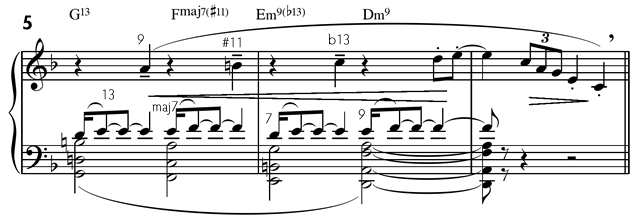Des pas sur la neige - Prelude by Claude Debussy
José Rodríguez Alvira
Measures 5 to 11
In measures 5 to 7 the notes D - E of the motive are presented over a G major chord (measure 5) and an E minor seventh chord (measure 6). In the first case the E adds a thirteenth to the G major chord. The D adds a minor seventh to E minor chord. The E- F notes are harmonized with an F major seventh chord (measure 5) and D minor (measure 6). The E adds the major seventh to the F chord and a ninth to the D minor chord.

Nicole Muller, piano - Piano Society
The right hand melody adds more extensions to the chords. The A over the G major chord adds a ninth, the B over the F chord an augmented eleventh and the C over the E minor chord adds a minor thirteenth. The melody is interrupted at measure 7 but will be further developed in the prelude.
In measures 8 to 11 the motive is harmonized with two dominant seventh chords (C and C#). The chords are somewhat hidden by appoggiaturas:

Nicole Muller, piano - Piano Society
The F# in the bass is an appoggiatura to the G. The D of the motive is another appoggiatura to the E of the C dominant chord that appears in the first two beats. In the third and fourth beats we have a C# dominant chord. This time the E of the motive is an appoggiatura to F that is enharmonically equivalent to an E# (third of C#). Measures 10 and 11 are a variation. The bass notes of the previous measures are substituted by a chromatic melody but the harmony remains basically the same (the C# chord is written as Db). This section ends with a Gb major chord in second inversion.